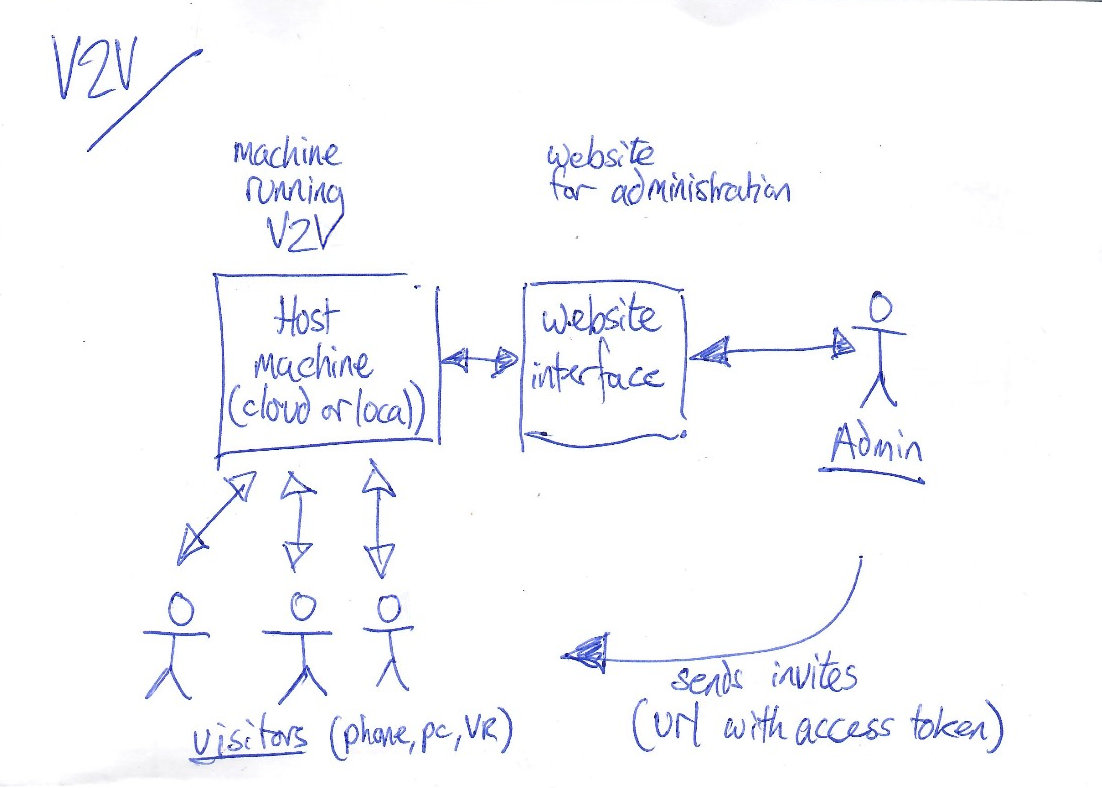V2V : Unreal Engine peer-to-peer VR meeting application with UGC
The Idea
A variety of use cases have been identified for a novel form of an open source, decentralised VR metaverse space that would allow a user to host a session and invite others to join. Participants can connect using VR, desktop computer / laptop or mobile device. For lower end devices (mobile devices) a pixel streaming option is to be made available (phase two of the project).

V2V System Overview
The essential idea is to offer Zoom / Skype style communication, but using VR instead of webcams and by connecting peer-to-peer instead of via centralised login servers. By sharing the experience of a 3D space, custom environments, 3D objects and mini games can be experienced by all users simultaneously. The intention is to offer a means of meeting and communicating in a 3D environment that behaves more like a 3D website browser with private peer-to-peer communication and less like an MMO. This decentralised, simplified approach provides users with the opportunity to produce near photorealistic graphics, greater creative freedom and enhanced privacy whilst reducing overall system complexity.
Unlike V2V, the various existing shared 3D environment / social VR platforms (VRChat, AltSpaceVR, Second Life, etc) are based on a centralised model that requires registration and logging in to third party servers. V2V also differs substantially from existing platforms in that it is intended only for providing smaller, ephemeral, private metaverse spaces.
Due to the focus of many existing platforms on in-application editing tools and other limiting factors, existing VR meeting places limit creative freedom and potential quality of graphics when creating or customising avatars, environments and other UGC.
By releasing the Unreal Engine project as open source it is intended that a community of developers and UGC creators will grow over time.
Intended Users Identified (so far)
| ~ Family and friends | ~ Product designers and clients |
| ~ Therapists and clients | ~ Teachers and students |
| ~ Architects and clients | ~ NFT owners and creators |
Business Case
The Covid pandemic has changed the online meeting and collaboration landscape. Increasingly, a hybrid model of employment is becoming popular[1] as people have become accustomed to working from home and avoiding travel. It is likely these new trends will continue after the pandemic has passed[2].
Example use cases for the planned application include:
- Product visualisation (e.g. importing 3D models of products or architectural designs)
- Teaching with the aid of animated 3D models (e.g. showing how a car engine works)
- Phobia therapy (e.g. public speaking, fear of flying[3])
- NFT display galleries where it is desirable to limit who can visit
Virtuality Co., Ltd was established in 2020 and owns a 50-camera Qualisys motion capture studio. Virtuality comprises staff experienced in character animation, software development and 3D modelling. As such, the company is well positioned to explore and implement novel ways of the opening up of human to human bandwidth through VR.
↑